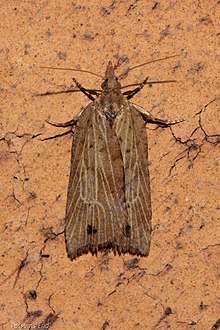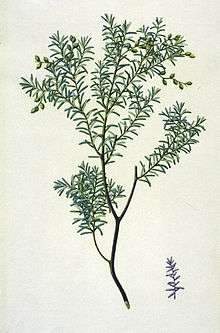Planotortrix notophaea
Planotortrix notophaea, the blacklegged leafroller, is a species of moth in the family Tortricidae. It is endemic to New Zealand. It was also present near Sydney in Australia, but this population is thought to be extinct.
| Planotortrix notophaea | |
|---|---|
 | |
| Male holotype specimen held at the Auckland War Memorial Museum. | |
| Scientific classification | |
| Kingdom: | |
| Phylum: | |
| Class: | |
| Order: | |
| Family: | |
| Genus: | |
| Species: | P. notophaea |
| Binomial name | |
| Planotortrix notophaea | |
| Synonyms[2] | |
| |
Taxonomy

This species was first described in 1926 by A. J. Turner and named Tortrix notophaea.[3] Turner used a specimen sent to him by Alfred Philpott that had been reared in New Zealand.[3] It had emerged from a cutting of Acacia decurrans that had been collecting at Epping, Sydney.[3] The holotype specimen used for this description is now held at the New Zealand Arthropod Collection.[2] No other specimens have been collected in Australia and as such that population is thought to be extinct.[4] It has been hypothesised that this specimen resulted from the species becoming established in Epping as a result of a commercial nursery near where it was collected.[5] In 1928 George Hudson illustrated this species under the name Tortrix excessana.[2] In 1946 J. T. Salmon, thinking he was describing a new subspecies, named this moth Ctenopseutis obliquana distincta.[6] The specimen Salmon used for this description was collected by Graham Turbutt on the 23 April 1946 at Great Island and is now held at the Auckland War Memorial Museum.[7] This name was synonymised by John S. Dugdale in 1966 and the species was placed by him within the genus Planotortrix.[5]
Description
The wingspan is 15–18 mm.[4] This species is a brown fuscous colour with antennae that are fuscous white.[3] The abdomen is grey with a lateral black stripe and fuscous coloured legs.[3] There is a diamond-shaped patch in the discal cell of the forewings.[4] This species can be variable in appearance.[4]
The larvae of this species have heads that are green with narrow brown stripes, a green body and white lateral stripes as well as black forelegs.[4]
Distribution
This species is endemic to New Zealand.[8][9] It is found on the Three Kings Islands, the South Island and the North Island.[4]
Habitat and host species

This species prefers coastal to montane forest habitat.[4] The larvae are polyphagous, but prefer small-leaved, hard-leaved gymnosperms and dicotyledonous angiosperms.[4] Endemic host species include Aristotelia serrata, Coprosma grandifolia, Metrosideros excelsa, and Prumnopitys taxifolia.[10] The larvae feed on leaves, buds and stems from a shelter made of foliage webbed together with silk.[11]
Human interactions
P. notonphaea is regarded as being a damaging pest of commercial conifer forests.[11] It is listed as a Quarantine Pest when exporting forest goods from New Zealand to other countries.[12]
References
| Wikimedia Commons has media related to Planotortrix notophaea. |
- Gilligan, T. M.; Baixeras, J.; Brown, J. W.; Tuck, K. R. "Planotortrix species". www.tortricidae.com. tortricid.net. Retrieved 19 January 2017.
- Dugdale, John S. (1988-09-23). "Lepidoptera - annotated catalogue, and keys to family-group taxa" (PDF). Fauna of New Zealand. 14: 1–264. Retrieved 3 May 2019.
- Turner, Alfred Jefferis (1926-01-01). "Studies in Australian Lepidoptera". Transactions of the Royal Society of South Australia. 50: 120–155 – via Biodiversity Heritage Library.
- Dugdale, J. S. (1990-07-01). "Reassessment of Ctenopseustis Meyrick and Planotortrix Dugdale with descriptions of two new genera (Lepidoptera: Tortricidae)". New Zealand Journal of Zoology. 17 (3): 437–465. doi:10.1080/03014223.1990.10422943. ISSN 0301-4223.
- Dugdale, J. S. (1966). "A new genus for the New Zealand 'elusive tortrix' (Lepidoptera: Tortricidae: Tortricinae)". New Zealand Journal of Science. 9 (2): 391–398.
- Salmon, J. T. (20 December 1948). "New Species and Records of Lepidoptera from the Three Kings Islands, New Zealand". Records of the Auckland Institute and Museum. 3 (4): 309–311. JSTOR 42906019.
- "Ctenopseustis obliquana distincta". www.aucklandmuseum.com. 22 November 2002. Retrieved 19 January 2017.
- "Planotortrix notophaea (Turner, 1926)". www.nzor.org.nz. Landcare Research New Zealand. Retrieved 2017-01-18.
- Gordon, Dennis P., ed. (2010). New Zealand inventory of biodiversity. Volume two. Kingdom animalia : chaetognatha, ecdysozoa, ichnofossils. Vol. 2. Christchurch, N.Z.: Canterbury University Press. p. 465. ISBN 9781877257933. OCLC 973607714.
- "Planotortrix notophaea (Turner, 1926) Herbivore report". plant-synz.landcareresearch.co.nz. Manaaki Whenua Landcare Research. Retrieved 2019-05-03.
- Nuttall, M. J. (1983). "Greenheaded leafroller, Blacklegged leafroller and Light Brown Apple Moth" (PDF). www.nzffa.org.nz. Retrieved 3 May 2019.
- "Forest Products Export Standards - Phytosanitary Requirements". www.mpi.govt.nz. 7 March 2017. Retrieved 3 May 2019.